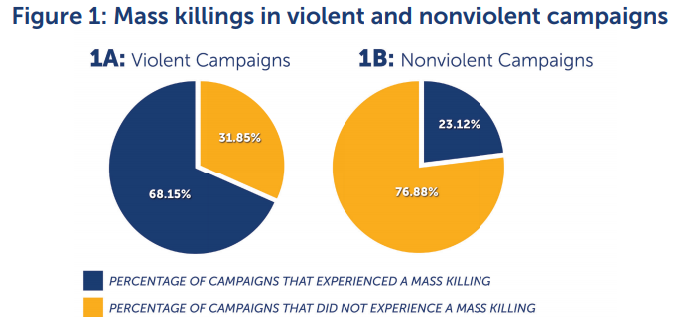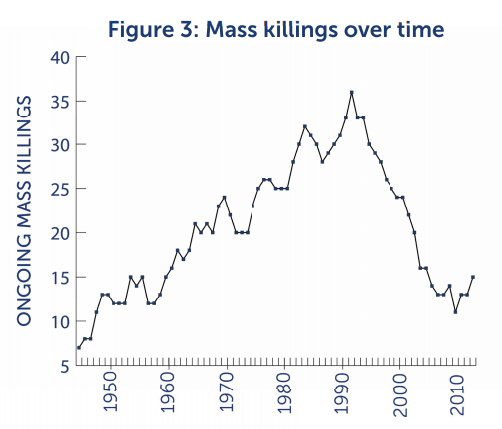
Oxfam’s Ed Cairns explores the evidence and experience on violence v non violence as a way of bringing about social change
One of the perennial themes of this blog is the idea that crises may provide an opportunity for progressive change. True. But I’ve always been nervous that such hopes can forget that most conflicts cause far more human misery than any good that may come.
This is something that Duncan and I have (non-violently) tussled about over the years. So imagine my delight when I saw a recent report that seems to back up my caution. The International Center on Nonviolent Conflict’s paper on Nonviolent Resistance and Prevention of Mass Killings looked at 308 popular uprisings up to 2013. It found that “nonviolent uprisings are almost three times less likely than violent rebellions to encounter mass killings,” which faced such brutal repression nearly 68% of the time. The authors, Erica Chenoweth and Evan Perkoski, think this is because violent campaigns threaten leaders and security forces alike, encouraging them to “hold on to power at any cost, even ordering or carrying out a mass atrocity in an attempt to survive.”
There is a positive lesson here, that nonviolence works – at least better than violence. This builds on Chenoweth’s earlier study, which suggested that between 2000 and 2006, 70% of nonviolent campaigns succeeded, five times the success rate for violent ones. Looking back over the 20th century, she found that non-violent campaigns succeeded 53% of the time, compared with 26% for violent resistance.

Again, there is a positive lesson – though it’d be interesting to know the figures since 2006, when the world appears to have become more repressive and violent. 2017 was the 12th year, according to the US-based Freedom House, “of decline in global freedom [as] seventy-one countries suffered net declines in political rights and civil liberties.” As the Uppsala Conflict Data Program shows, these years of pressure on rights have coincided with sharp rises in conflicts since the start of this decade. And according to the 2018 Global Peace Index, just out this month, “peacefulness has declined year on year for eight of the last ten years.” This seems to suggest that in our violent and challenging decade, nonviolent campaigns have found it tough in many countries too.
Tragically, this may breed a climate of desperation. In another recent article, Robin Luckham wrote that “the temptations of violence… are even stronger when authoritarian regimes violently crush non-violent protests…The turn from non-violent to violent resistance can easily open the way for more ruthless and better armed groups to step into the political spaces initially opened up by peaceful protests, as in Syria and Libya.”
This brings us perhaps to a less positive lesson – that living under tyrannies may be less worse than violent campaigns to change them. Chenoweth and Perkoski argue that “popular uprisings are not all alike. Some, like those in Libya (2011) and eventually Syria (2011), are predominantly violent, wherein the opposition chooses to take up arms to challenge the status quo. Others, like Tunisia (2010), Egypt (2011), and Burkina Faso (2014), eschew violence altogether.”
“Choose to take up arms”? That’s a harsh way to describe the situation at least some armed groups have faced. We should never forget that state repression often drives uprisings to become more violent. But looking at the historical evidence in these articles – and at almost every conflict now – it’s difficult to escape the conclusion that armed resistance is seldom successful, often counterproductive, and therefore rarely justifiable.

This begs one final question which Chenoweth and Perkoski can help with. Few would now argue that foreign countries should intervene to change regimes. But the UK Parliamentary Foreign Affairs Committee is conducting an enquiry on the prospect of military interventions for a different purpose – to stop mass killings. Its chair, Thomas Tugendhat, suggested that ‘The Cost of Doing Nothing’ in Syria had been thousands and thousands of lives.
I’ve never been convinced of that case in Syria, though the world’s failure to stop the genocides in Rwanda and Bosnia in the 1990s was among the most shameful events of our times. But Chenoweth and Perkoski highlight the danger of any kind of foreign intervention. The likelihood of mass killings increases, they conclude, both “when foreign states provide material aid to dissidents… [and] to the governments the movements oppose.” In the first case, that’s because foreign support to oppositions encourages states to perceive them “as an existential threat.”
We shouldn’t conclude that military action will never ever be justified to prevent mass killings. But we know more reasons for caution than we once did. Every foreign action needs to be carried out with the best possible knowledge of its consequences.
That’s a harder thing to do than in the 1990s, when this debate first forced its way onto humanitarian agendas. According to a UN/World Bank study, there were eight armed groups in an average civil war in the 1950s. By 2010, there were fourteen. In Syria in 2014, there were more than a thousand. While more local parties are fighting within borders, regional powers – like Saudi Arabia and Iran – as well as Russia and the US are more willing to contemplate war, in what Robert Malley of Crisis Group calls the world’s “growing militarization of foreign policy.” It is in this dangerous world that the risks of military action are higher than when the ideas of “humanitarian intervention” and Responsibility to Protect were developed.
I’ve never believed that pacifism is an adequate answer to a world of atrocities that – in truly exceptional cases – call out for an armed response. But there’s an awful lot of evidence for caution – and reason to give peace a chance.